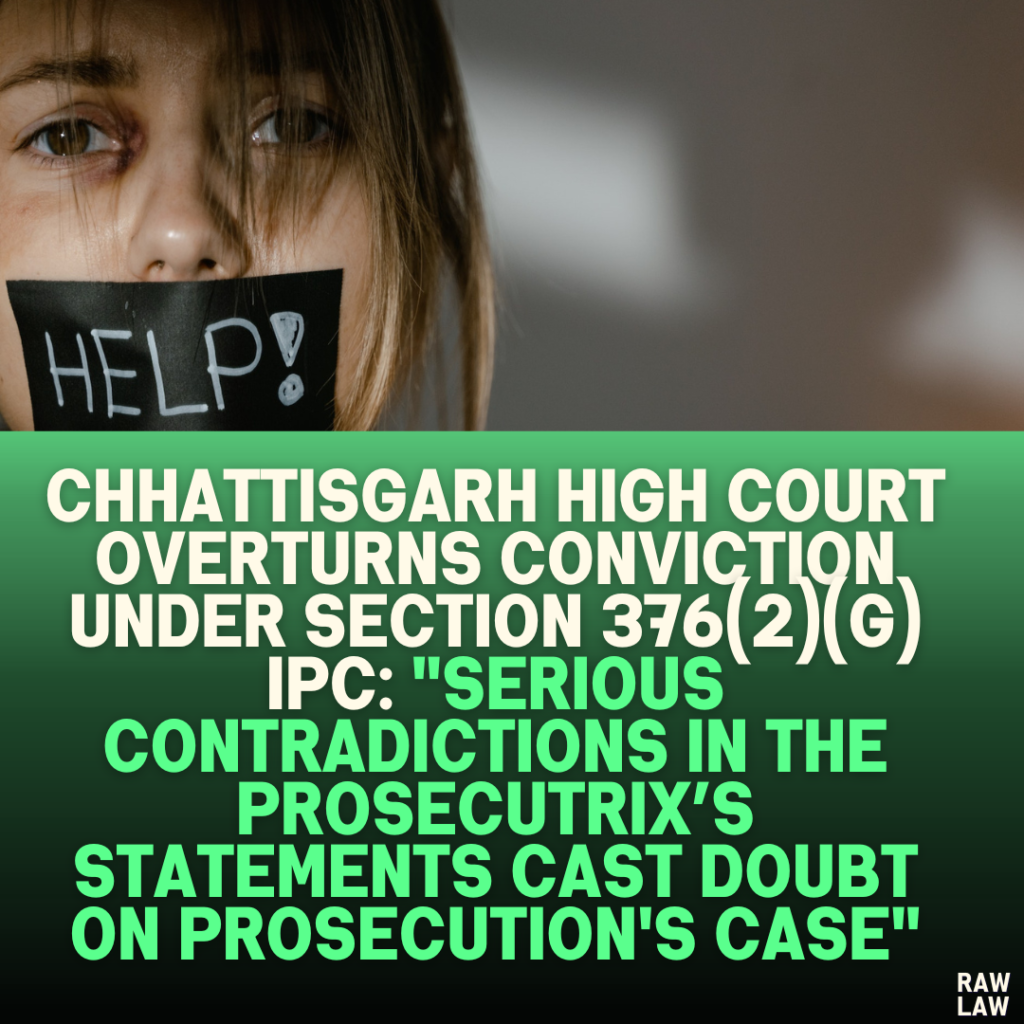Court’s Decision
The High Court of Chhattisgarh overturned the trial court’s conviction of the appellant under Section 376(2)(g) IPC (gang rape), citing significant inconsistencies in the prosecution’s evidence. The appellant was acquitted, benefiting from the principle of reasonable doubt. The court ordered the refund of any fines paid by the appellant and extended the bail bonds for six months under Section 437-A of the Code of Criminal Procedure (CrPC).
Facts
- The incident occurred on April 8, 1999, when the prosecutrix alleged that two individuals, Radheshyam and Ramkhilawan (the appellant), came to her house while she was alone.
- The prosecutrix claimed that Radheshyam committed rape while the appellant stood outside the house.
- The prosecutrix lodged an FIR on the same day, and a charge sheet was filed after the investigation.
- Medical examination conducted on the prosecutrix indicated she was habituated to sexual intercourse, with no definitive signs of recent sexual activity. The forensic examination did not find semen stains or sperm on her clothing or body.
- The trial court convicted the appellant and sentenced him to 10 years of rigorous imprisonment under Section 376(2)(g) IPC.
Issues
- Was the prosecution able to prove beyond reasonable doubt that the appellant was involved in the alleged gang rape?
- Did inconsistencies in the evidence, including the prosecutrix’s statements, undermine the prosecution’s case?
Petitioner’s Arguments
- Age of Prosecutrix: The appellant’s counsel argued that the prosecutrix’s age was misrepresented. Although the prosecution claimed she was 15 years old at the time of the incident, the prosecutrix herself stated in court that she was 18 years old at the time. No documentary evidence of her age was submitted, and the ossification test suggested her age could vary by 2-3 years.
- Contradictions in Testimony: The prosecutrix’s statements were contradictory:
- In the FIR and initial police statements, she stated the appellant stood outside and did not commit rape.
- In court, she claimed the appellant participated in the rape.
- She identified the appellant in court but failed to name him in her earlier statements.
- Lack of Corroborative Evidence: The defense highlighted the absence of corroborative medical and forensic evidence. No semen or sperm was detected, and witness statements did not substantiate the prosecutrix’s claims.
Respondent’s Arguments
- The prosecution argued that the prosecutrix’s testimony alone was sufficient for conviction.
- The prosecution contended that the appellant’s identity was established and that the absence of physical evidence should not weaken the prosecutrix’s statement.
- The prosecution relied on circumstantial evidence and the prosecutrix’s identification of the appellant.
Analysis of the Law
- Section 376(2)(g) IPC: For a conviction under this section, it must be proven that multiple individuals acted in concert to commit the crime. The burden lies on the prosecution to establish this beyond reasonable doubt.
- Principle of Reasonable Doubt: Criminal law mandates that conviction requires clear and unambiguous evidence. Any contradictions or lack of clarity must benefit the accused.
- Reliance on Testimony: While a prosecutrix’s testimony can form the basis for conviction, it must be consistent, credible, and corroborated when possible. Contradictions weaken its evidentiary value.
Precedent Analysis
The judgment reflects established principles from earlier rulings:
- Testimony of the prosecutrix must be reliable and consistent to form the sole basis for conviction.
- Corroborative evidence becomes critical when the prosecutrix’s statements contain inconsistencies.
- Courts have emphasized the need for proof beyond reasonable doubt, especially in cases involving severe punishments.
Court’s Reasoning
- Contradictory Testimonies: The court noted serious contradictions in the prosecutrix’s statements. Initially, she alleged that the appellant stood outside during the incident. Later, she claimed he actively participated. Such inconsistencies undermined her credibility.
- Lack of Evidence:
- Medical examination failed to corroborate allegations of recent sexual activity.
- Forensic analysis did not find any incriminating material, such as semen or sperm.
- Witnesses (PW-2 and PW-3), close relatives of the prosecutrix, denied knowledge of the incident and failed to confirm the appellant’s identity.
- Age of the Prosecutrix: The prosecution failed to provide documentary proof of the prosecutrix’s age, and her ossification test was inconclusive. This made it impossible to establish her as a minor at the time of the incident.
- Doubtful Identification: The prosecutrix did not name the appellant in her earlier statements. Witnesses also denied recognizing the appellant. The FIR, which named the appellant, became suspicious in light of these facts.
- Inconsistent Prosecution Case: The court emphasized that discrepancies in evidence, lack of corroboration, and unreliable testimony failed to meet the standard of proof required for conviction.
Conclusion
The High Court concluded that the prosecution had not proven its case beyond reasonable doubt. The conviction and sentence under Section 376(2)(g) IPC were set aside, and the appellant was acquitted. The court directed that any fines paid by the appellant be refunded and his bail bonds extended for six months.
Implications
- Reinforcement of Evidence Standards: The judgment underscores the necessity of consistent and corroborated evidence in criminal trials.
- Protection of Rights: The decision highlights the importance of safeguarding the rights of the accused, ensuring convictions are based on credible and substantiated evidence.
- Judicial Integrity: The ruling reaffirms the principle that serious charges must be proven beyond reasonable doubt to maintain the integrity of the judicial system.



